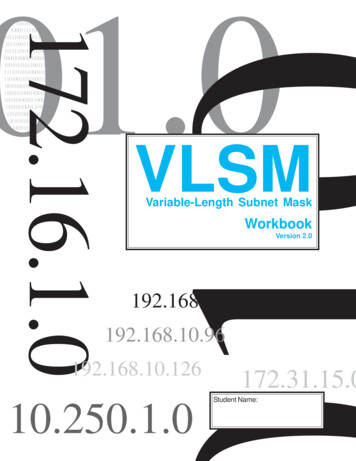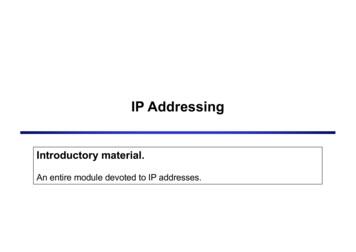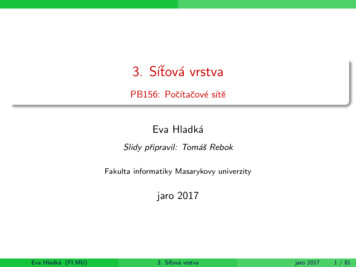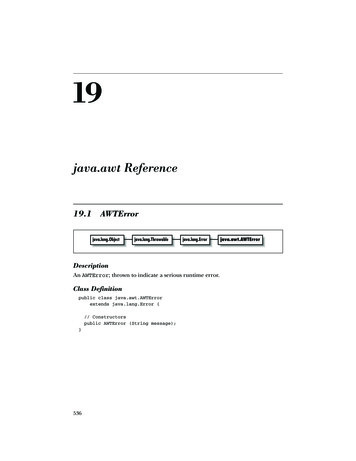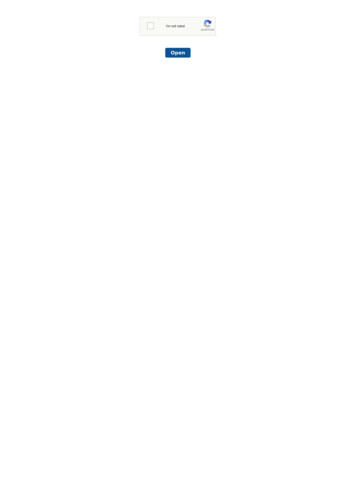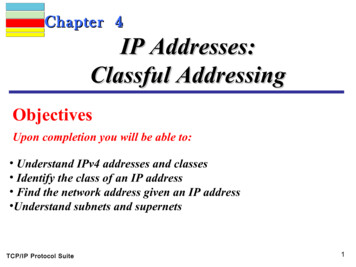
Transcription
Chapter 4IP Addresses:Classful AddressingObjectivesUpon completion you will be able to: Understand IPv4 addresses and classes Identify the class of an IP address Find the network address given an IP address Understand subnets and supernetsTCP/IP Protocol Suite1
4.1 INTRODUCTIONThe identifier used in the IP layer of the TCP/IP protocol suite toidentify each device connected to the Internet is called the Internetaddress or IP address. An IP address is a 32-bit address that uniquelyand universally defines the connection of a host or a router to theInternet. IP addresses are unique. They are unique in the sense thateach address defines one, and only one, connection to the Internet. Twodevices on the Internet can never have the same address.The topics discussed in this section include:Address SpaceNotationTCP/IP Protocol Suite2
Note:An IP address is a 32-bit address.TCP/IP Protocol Suite3
Note:The IP addresses are unique.TCP/IP Protocol Suite4
Note:The address space of IPv4 is232 or 4,294,967,296.TCP/IP Protocol Suite5
Figure 4.1TCP/IP Protocol SuiteDotted-decimal notation6
Note:The binary, decimal, and hexadecimalnumber systems are reviewed inAppendix B.TCP/IP Protocol Suite7
ExamplE 1Change the following IP addresses from binary notation todotted-decimal notation.a. 10000001 00001011 00001011 11101111b. 11000001 10000011 00011011 11111111c. 11100111 11011011 10001011 01101111d. 11111001 10011011 11111011 00001111SolutionWe replace each group of 8 bits with its equivalent decimalnumber (see Appendix B) and add dots for separation:a. 129.11.11.239c. 231.219.139.111TCP/IP Protocol Suiteb. 193.131.27.255d. 249.155.251.158
ExamplE 2Change the following IP addresses from dotted-decimalnotation to binary notation.a. 111.56.45.78c. 241.8.56.12b. 221.34.7.82d. 75.45.34.78SolutionWe replace each decimal number with its binary equivalent:a. 01101111 00111000 00101101 01001110b. 11011101 00100010 00000111 01010010c. 11110001 00001000 00111000 00001100d. 01001011 00101101 00100010 01001110TCP/IP Protocol Suite9
ExamplE 3Find the error, if any, in the following IP addresses:a. 111.56.045.78b. 221.34.7.8.20c. 75.45.301.14d. 11100010.23.14.67Solutiona. There are no leading zeroes in dotted-decimal notation (045).b. We may not have more than four numbers in an IP address.c. In dotted-decimal notation, each number is less than or equalto 255; 301 is outside this range.d. A mixture of binary notation and dotted-decimal notation isnotTCP/IP Protocol Suiteallowed.10
ExamplE 4Change the following IP addresses from binary notation tohexadecimal notation.a. 10000001 00001011 00001011 11101111b. 11000001 10000011 00011011 11111111SolutionWe replace each group of 4 bits with its hexadecimalequivalent (see Appendix B). Note that hexadecimal notationnormally has no added spaces or dots; however, 0X (or 0x) isadded at the beginning or the subscript 16 at the end to showthat the number is in hexadecimal.a. 0X810B0BEF or 810B0BEF16b. 0XC1831BFF or C1831BFF16TCP/IP Protocol Suite11
4.2 CLASSFUL ADDRESSINGIP addresses, when started a few decades ago, used the concept ofclasses. This architecture is called classful addressing. In the mid-1990s,a new architecture, called classless addressing, was introduced and willeventually supersede the original architecture. However, part of theInternet is still using classful addressing, but the migration is very fast.The topics discussed in this section include:Recognizing ClassesNetid and HostidClasses and BlocksNetwork AddressesSufficient InformationMaskCIDR NotationAddress DepletionTCP/IP Protocol Suite12
Figure 4.2TCP/IP Protocol SuiteOccupation of the address space13
Table 4.1 Addresses per classTCP/IP Protocol Suite14
Figure 4.3TCP/IP Protocol SuiteFinding the class in binary notation15
Figure 4.4TCP/IP Protocol SuiteFinding the address class16
ExamplE 5How can we prove that we have 2,147,483,648 addresses inclass A?SolutionIn class A, only 1 bit defines the class. The remaining 31 bitsare available for the address. With 31 bits, we can have 2 31or 2,147,483,648 addresses.TCP/IP Protocol Suite17
ExamplE 6Find the class of each address:a. 00000001 00001011 00001011 11101111b. 11000001 10000011 00011011 11111111c. 10100111 11011011 10001011 01101111d. 11110011 10011011 11111011 00001111SolutionSee the procedure in Figure 4.4.a. The first bit is 0. This is a class A address.b. The first 2 bits are 1; the third bit is 0. This is a class C address.c. The first bit is 0; the second bit is 1. This is a class B address.d. The first 4 bits are 1s. This is a class E address.TCP/IP Protocol Suite18
Figure 4.5TCP/IP Protocol SuiteFinding the class in decimal notation19
ExamplE 7Find the class of each address:a.227.12.14.87b.193.14.56.22d. 252.5.15.111e.134.11.78.56c.14.23.120.8Solutiona. The first byte is 227 (between 224 and 239); the class is D.b. The first byte is 193 (between 192 and 223); the class is C.c. The first byte is 14 (between 0 and 127); the class is A.d. The first byte is 252 (between 240 and 255); the class is E.e. The first byte is 134 (between 128 and 191); the class is B.TCP/IP Protocol Suite20
ExamplE 8In Example 5 we showed that class A has 231 (2,147,483,648)addresses. How can we prove this same fact using dotteddecimal notation?SolutionThe addresses in class A range from 0.0.0.0 to127.255.255.255. We need to show that the difference betweenthese two numbers is 2,147,483,648. This is a good exercisebecause it shows us how to define the range of addressesbetween two addresses. We notice that we are dealing with base256 numbers here. Each byte in the notation has a weight. Theweights are as follows (see Appendix B):See Next SlideTCP/IP Protocol Suite21
ExamplE 8(continuEd)2563, 2562, 2561, 2560Now to find the integer value of each number, we multiplyeach byte by its weight:Last address: 127 2563 255 2562 255 2561 255 2560 2,147,483,647First address: 0If we subtract the first from the last and add 1 to the result(remember we always add 1 to get the range), we get2,147,483,648 or 231.TCP/IP Protocol Suite22
Figure 4.6TCP/IP Protocol SuiteNetid and hostid23
Note:Millions of class A addresses arewasted.TCP/IP Protocol Suite24
Figure 4.7TCP/IP Protocol SuiteBlocks in class A25
Figure 4.8TCP/IP Protocol SuiteBlocks in class B26
Note:Many class B addresses are wasted.TCP/IP Protocol Suite27
Figure 4.9TCP/IP Protocol SuiteBlocks in class C28
Note:The number of addresses in class C issmaller than the needs of mostorganizations.TCP/IP Protocol Suite29
Note:Class D addresses are used formulticasting; there is only one block inthis class.TCP/IP Protocol Suite30
Note:Class E addresses are reserved forfuture purposes; most of the block iswasted.TCP/IP Protocol Suite31
Note:In classful addressing, the networkaddress (the first address in the block)is the one that is assigned to theorganization. The range of addressescan automatically be inferred from thenetwork address.TCP/IP Protocol Suite32
ExamplE 9Given the network address 17.0.0.0, find the class, the block,and the range of the addresses.SolutionThe class is A because the first byte is between 0 and 127. Theblock has a netid of 17. The addresses range from 17.0.0.0 to17.255.255.255.TCP/IP Protocol Suite33
ExamplE10Given the network address 132.21.0.0, find the class, the block,and the range of the addresses.SolutionThe class is B because the first byte is between 128 and 191.The block has a netid of 132.21. The addresses range from132.21.0.0 to 132.21.255.255.TCP/IP Protocol Suite34
ExamplE11Given the network address 220.34.76.0, find the class, theblock, and the range of the addresses.SolutionThe class is C because the first byte is between 192and 223. The block has a netid of 220.34.76. Theaddresses range from 220.34.76.0 to 220.34.76.255.TCP/IP Protocol Suite35
Figure 4.10TCP/IP Protocol SuiteMasking concept36
Figure 4.11TCP/IP Protocol SuiteAND operation37
Table 4.2 Default masksTCP/IP Protocol Suite38
Note:The network address is the beginningaddress of each block. It can be foundby applying the default mask to any ofthe addresses in the block (includingitself). It retains the netid of the blockand sets the hostid to zero.TCP/IP Protocol Suite39
ExamplE12Given the address 23.56.7.91, find the beginning address(network address).SolutionThe default mask is 255.0.0.0, which means that only the firstbyte is preserved and the other 3 bytes are set to 0s. Thenetwork address is 23.0.0.0.TCP/IP Protocol Suite40
ExamplE13Given the address 132.6.17.85, find the beginning address(network address).SolutionThe default mask is 255.255.0.0, which means that the first 2bytes are preserved and the other 2 bytes are set to 0s. Thenetwork address is 132.6.0.0.TCP/IP Protocol Suite41
ExamplE14Given the address 201.180.56.5, find the beginning address(network address).SolutionThe default mask is 255.255.255.0, which means that the first 3bytes are preserved and the last byte is set to 0. The networkaddress is 201.180.56.0.TCP/IP Protocol Suite42
Note:Note that we must not apply thedefault mask of one class to an addressbelonging to another class.TCP/IP Protocol Suite43
4.4 SUBNETTING ANDSUPERNETTINGIn the previous sections we discussed the problems associated withclassful addressing. Specifically, the network addresses available forassignment to organizations are close to depletion. This is coupled withthe ever-increasing demand for addresses from organizations that wantconnection to the Internet. In this section we briefly discuss twosolutions: subnetting and supernetting.The topics discussed in this section include:SubnettingSupernettingSupernet MaskObsolescenceTCP/IP Protocol Suite44
Note:IP addresses are designed with twolevels of hierarchy.TCP/IP Protocol Suite45
Figure 4.20TCP/IP Protocol SuiteA network with two levels of hierarchy (not subnetted)46
Figure 4.21TCP/IP Protocol SuiteA network with three levels of hierarchy (subnetted)47
Figure 4.22TCP/IP Protocol SuiteAddresses in a network with and without subnetting48
Figure 4.23TCP/IP Protocol SuiteHierarchy concept in a telephone number49
Figure 4.24TCP/IP Protocol SuiteDefault mask and subnet mask50
ExamplE15What is the subnetwork address if the destination address is200.45.34.56 and the subnet mask is 255.255.240.0?SolutionWe apply the AND operation on the address and the subnetmask.Address 11001000 00101101 00100010 00111000Subnet Mask 11111111 11111111 11110000 00000000Subnetwork Address 11001000 00101101 00100000 00000000.TCP/IP Protocol Suite51
Figure 4.25TCP/IP Protocol SuiteComparison of a default mask and a subnet mask52
Figure 4.26TCP/IP Protocol SuiteA supernetwork53
Note:In subnetting, we need the firstaddress of the subnet and the subnetmask to define the range of addresses.In supernetting, we need the firstaddress of the supernet and thesupernet mask to define the range ofaddresses.TCP/IP Protocol Suite54
Figure 4.27TCP/IP Protocol SuiteComparison of subnet, default, and supernet masks55
Note:The idea of subnetting andsupernetting of classful addresses isalmost obsolete.TCP/IP Protocol Suite56
classes. This architecture is called classful addressing. In the mid-1990s, a new architecture, called classless addressing, was introduced and will eventually supersede the original architecture. However, part of the Internet is still using classful addressing, but the migration is very fast. The topics discussed in this section include:
